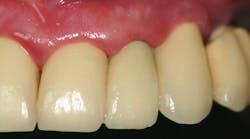Anatomically accurate models aid implant dentistry
Boston, MA –– BMi Biomedical Modeling, Inc. has published a brochure outlining the ways BioDental models clearly distinguish between bone and soft tissue while highlighting the inferior alveolar nerve channel to aid in visualizing, planning, and placing dental implants.
Photos show how these models clearly depict teeth, roots, and sinus features, provide a surgical guide, and can be incorporated into articulated models.
The brochure explains how BMi translates CT scans into accurate models of a patient's mandible or maxilla. A laser sculpts photopolymer resin to create a stereolithographic model that can be used to make the precise measurements needed to fabricate drilling guides.
Working with these models, dental labs can fabricate custom drill guides, as well as bone, tooth, or gingival supported stents, and diagnostic waxups.
The brochure also reports on the experiences of a number of dentists who have used these BioDental models to optimize implant positioning and angulation. The models help in communicating with patients too. For example, they enable a patient to see just why a bone graft would be needed.
Applications are detailed where BMi provided BioModels to assist in reconstructive surgery. A BMi BioModel played a key role in the separation of the conjoined Guatemalan twins, Maria Teresa and Maria de Jesus Quiej Alverez as well as in reconstructing the face of King Tut featured in a recent edition of Time Magazine.
For a copy of the brochure or for more information about BMi BioDental Models, contact Biomedical Modeling, Inc. at 888-246-6633, www.biomodel.com,167 Corey Road, Boston, MA 02135.

